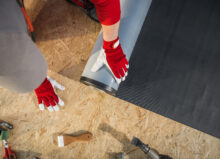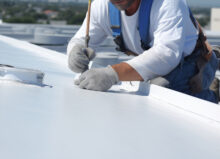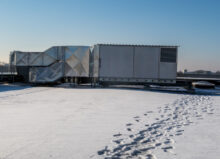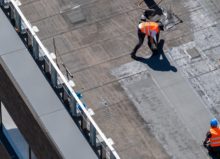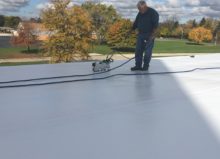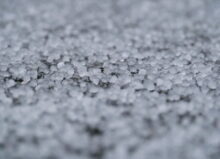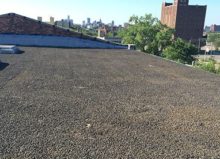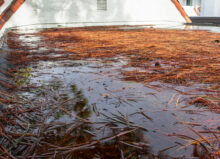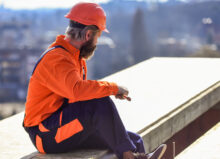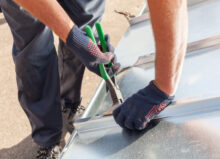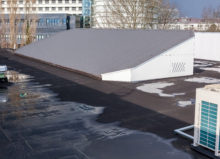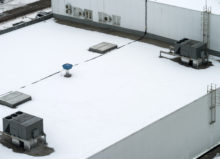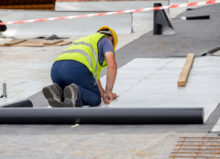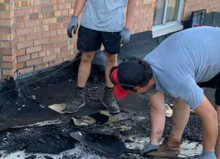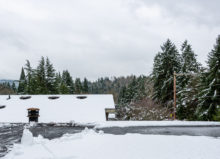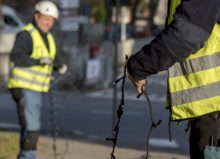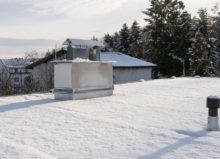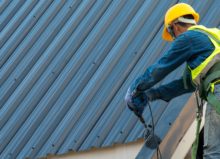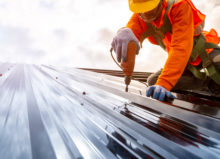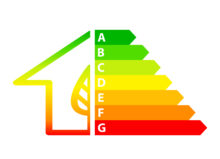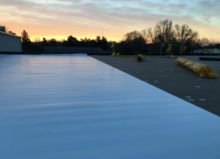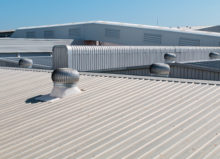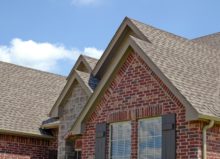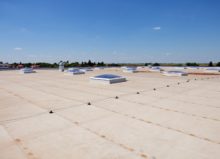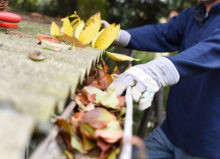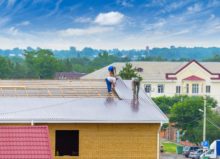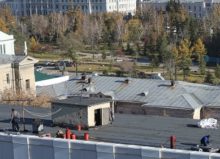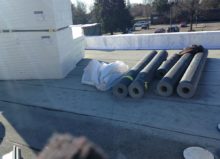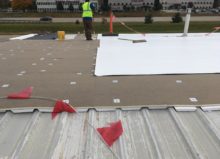Your Complete Guide to Low- & Flat-Slope Roofing Systems
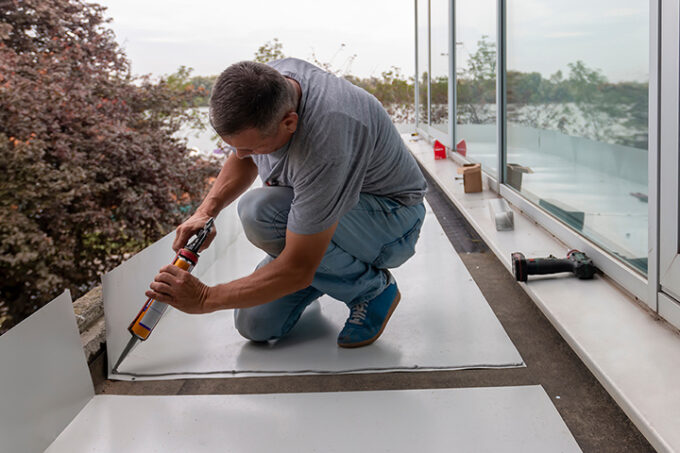
What goes into choosing a commercial roofing system? Of course, cost plays a part, but you also have to consider the weather conditions the roof is likely to encounter, the building’s style, what the building is used for, and whether the roof is flat or slanted.
In this article, we’ll cover some of the most common roofing systems used on low—and flat-slope buildings and the factors to consider when choosing one for your property.
Flat Vs. Low-Slope Roofs
Flat Roofs
Flat roofs are standard designs for commercial buildings because they’re simple and cost-effective. Flat roofs are actually not perfectly horizontal but have a slight slope (usually less than 10 degrees) to allow water to drain. These roofing systems are typically ideal for large industrial or commercial spaces, like warehouses, shopping centers, and office buildings, where cost and internal space maximization are important.
Low-Slope Roofs
Low-slope roofs have a slight incline, usually between 10 and 30 degrees. They provide better water management than flat roofs and reduce the risk of leaks, so it’s an ideal choice for any building that needs efficient drainage.
EPDM
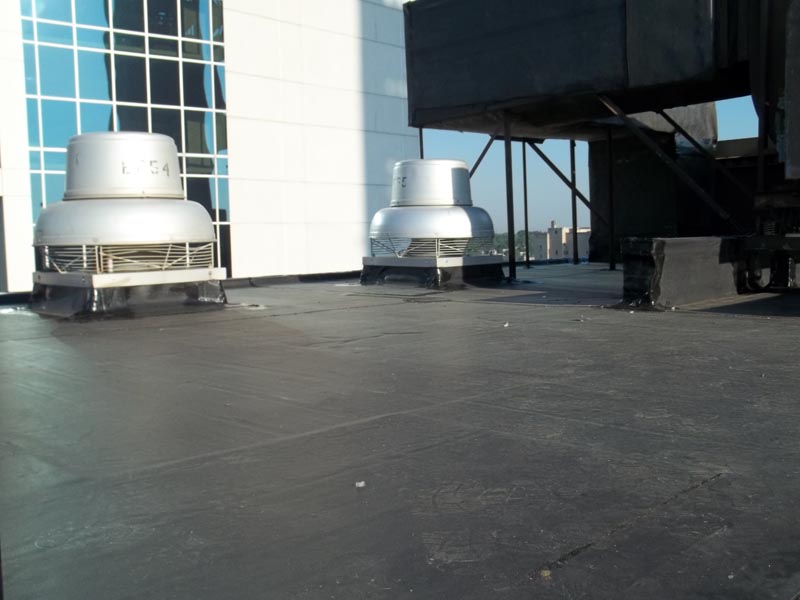
EPDM, or Ethylene Propylene Diene Monomer, has been a popular roofing system for a while. This material’s main selling points are its price and heat absorption capabilities, which make it extremely reliable and cost-effective during hot summers.
Advantages
- Remains flexible despite temperature extremes
- Can withstand harsh conditions
- Can last up to 25 years with proper maintenance
- Lightweight, so puts less stress on the structure
- Low maintenance
- Heat- and fire-resistant
- Not affected by UV radiation
Disadvantages
- Typically only available in black or white, limiting design options compared to other roofing materials
- Can be susceptible to punctures from falling branches, foot traffic, or installation of other equipment on the roof
- The seams can fail over time if not maintained, leading to leaks
- Material fatigue or failure around vents and drains is possible
The good news is that you can avoid most of these disadvantages if you hire a team that can properly install your EPDM roof.
PVC
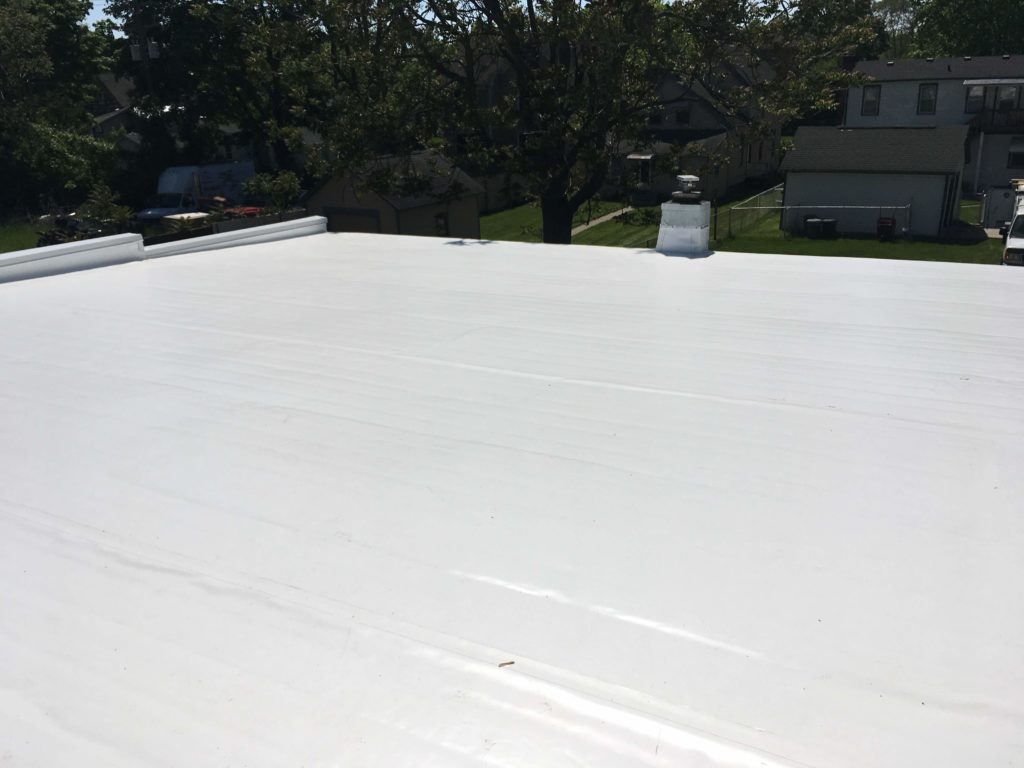
PVC is a single-ply material that maintains a watertight finish and features resilient seams. These seams are often stronger than those with EPDM roofs due to the heat-welded process used to create the permanent bond between the sheets. Because of these advantages, PVC is often the most popular choice for flat roofs. Most roofers can even guarantee a breaking point of at least 300 pounds for each inch, which exceeds the industry standard of 200 pounds per inch.
In many cases, PVC roofs have lighter coloring, making them more energy efficient. The light color allows the roof to reflect heat instead of absorbing it, keeping the interior at a more manageable temperature.
Advantages
- Permanent bond between sheets, reducing the chance of leaks
- Earned an Energy Star rating
- High resistance to water ponding, fire, mold/mildew, and UV radiation
- Can last as long as 30 years
Disadvantages
- Can be sensitive to certain chemicals like solvents and oils
- Tends to be more expensive than other single-ply roofing materials like TPO and EPDM
- Can eventually shrink over time from exposure to the elements, which can pull at the seams and flashing
- Can become brittle, especially in colder climates
- Can expand and contract significantly with temperature changes, leading to mechanical stresses at seams and around penetrations
Modified Bitumen

Modified bitumen, also known as APP (Atactic Polypropylene), is made from asphalt, polymers, and fillers and has been a popular alternative in commercial roofing for over 30 years. Unlike EPDM and PVC, modified bitumen roofing is multi-ply, which makes them far more resilient when coming into contact with sharp objects.
Advantages
- Easy to repair
- High durability and resistance to tears and punctures
- Available in a variety of colors and can mimic the look of more traditional roofing materials
Disadvantages
- Quality is very dependent on roofing installation; inadequate torching or improper use of adhesives can lead to early failures, such as leaks and seam separation
- Can absorb a significant amount of heat, leading to higher cooling costs, although reflective coatings can help mitigate this issue
- Can be susceptible to damage from foot traffic, especially on softer, more flexible types
- Not environmentally friendly, as the manufacturing process involves volatile organic compounds and other emissions
- Lifespan is lower than EPDM and PVC
- Can become brittle and more prone to cracking in colder climates
TPO
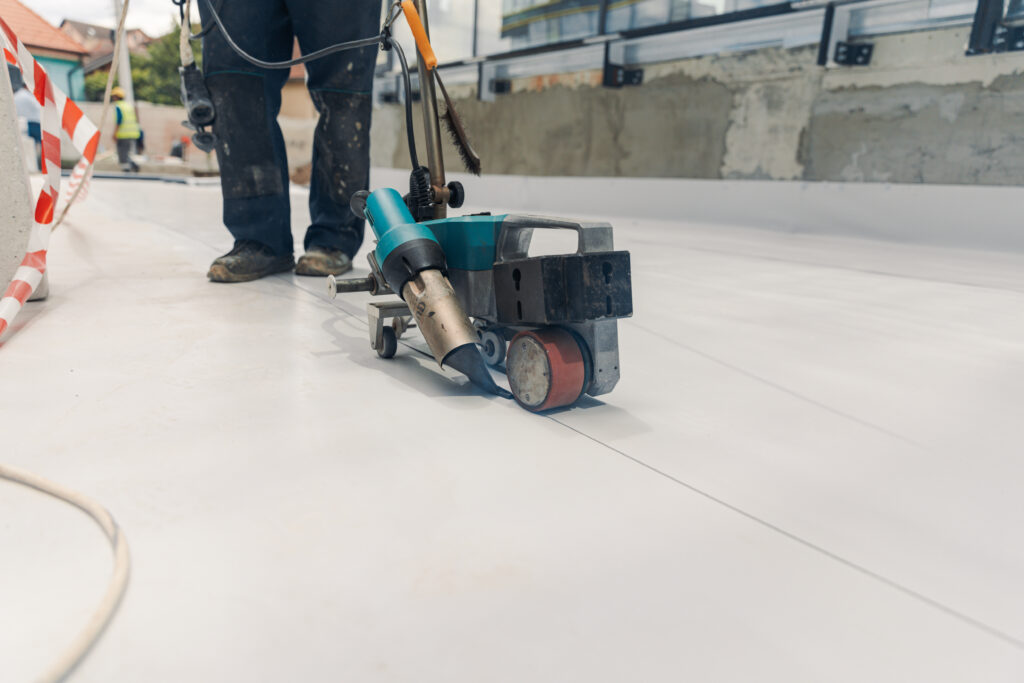
TPO (Thermoplastic Polyolefin) roofing systems manufactured in the United States have gained popularity because of their relatively low cost. However, this type of system isn’t as tried-and-trued as EPDM and PVC, leading to some questions and concerns on its overall performance, longevity, and reliability.
Advantages
- Is highly reflective and could help reduce cooling costs
- Is resistant to mold growth, dirt accumulation, and tears due to flexibility
- Lower cost in terms of material and installation
- Is available in many thicknesses and widths
- 100% recyclable
Disadvantages
- Formulations can vary significantly between manufacturers, impacting quality and longevity
- Actual lifespan can vary—no average lifespan
- Has some performance issues when used in consistently hot climates and areas with high UV radiation
- Even when the flame has been removed (during the welding/installation process), TPO continues to burn
- Cut membrane edges must be sealed to prevent water absorption
- Patching, re-welding, and other repairs can be challenging
Built-Up
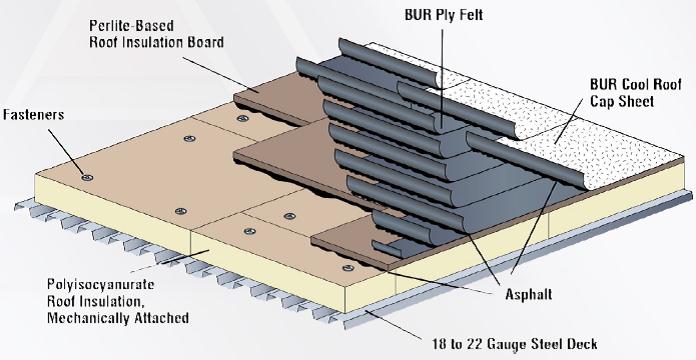
BUR (built-up roofing) consists of layers of bitumen or asphalt and fabric with gravel or aggregate stone making up the final layer.
You’ll find three kinds of built-up roofing systems on the market:
Ballasted Asphalt
A built-up ballasted asphalt roof system uses larger stones as its top layer because they aren’t attached to the roof membrane. This tactic, plus strategically placed fasteners and plates, prevents any movement. The system can be installed regardless of the weather, and the finished roof is highly fire-resistant.
Cold Built-Up
Like the ballasted asphalt system, a cold built-up roof can be installed in any weather using a squeegee. During installation, no toxic fumes are emitted.
Hot Built-Up
Hot build-up is the most difficult built-up roofing system to install because it requires liquefied bitumen that releases hazardous fumes and vapors.
Advantages
- Can last up to 30 years
- Strong resistance to UV radiation
- Longer life under changing weather conditions
- Waterproof
Disadvantages
- Higher cost due to installation complexity
- Potential for damage from water and wind
- Heavy due to the multiple layers of bitumen and reinforcing fabrics, requiring some additional engineering and construction to ensure structural integrity
- Requires periodic recoating to ensure continued protection against water
- Can become brittle with age, particularly in colder climates
Metal
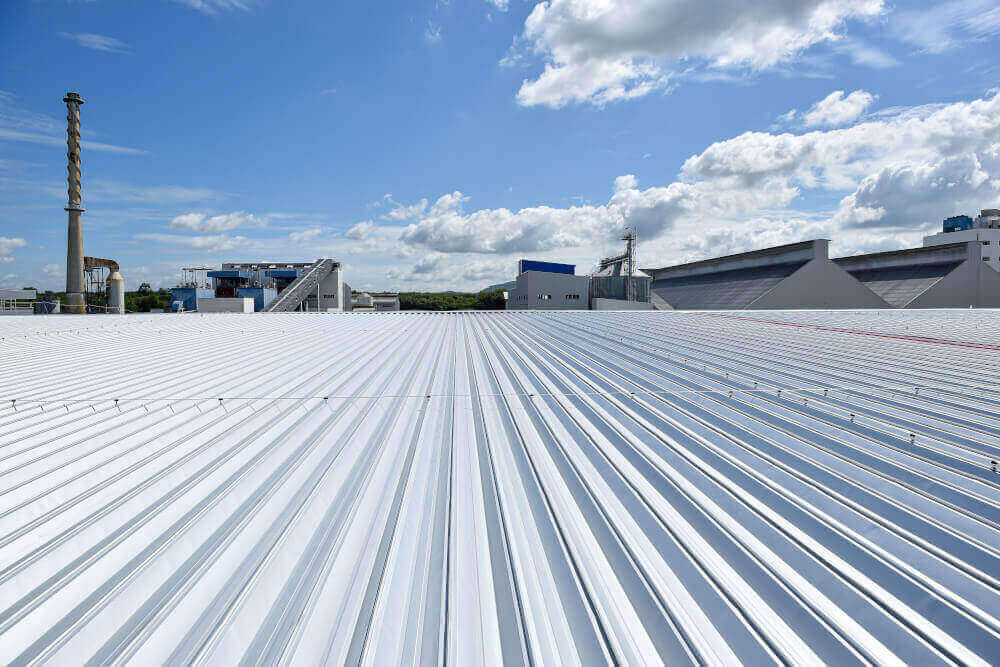
Metal roofing is a durable and versatile option that all types of buildings could benefit from. These roofing systems can be made from different types of metals, including steel, aluminum, copper, and zinc. They’re primarily known for their longevity, resistance to severe weather, and eco-friendliness.
Advantages
- Can last up to 50 years with proper maintenance
- Low maintenance requirements, especially for standing steam metal systems
- 100% recyclable
- Great for flat, low, and steep-slope (slope of 3:12 or more) roofs
- Highly resistant to heavy snow, hail, extreme temperatures, cracking, fire, and insect damage
- Reflects solar radiant heat, which can reduce cooling costs
Disadvantages
- Can be more expensive than other roofing materials, but the higher cost can be offset by the roof’s longer lifespan and lower maintenance costs
- Can be noisier than other roofing materials during rain or hail, but that can be remediated with added insulation
- If a repair is needed, it can be difficult to match the existing metal exactly due to normal weathering or differences in dye lots
- Can expand and contract, which makes them loosen over time, unless they were installed with a fastening system that can accommodate the movement
- Can be dented from hail or heavy falling branches if the metal is thinner
Green
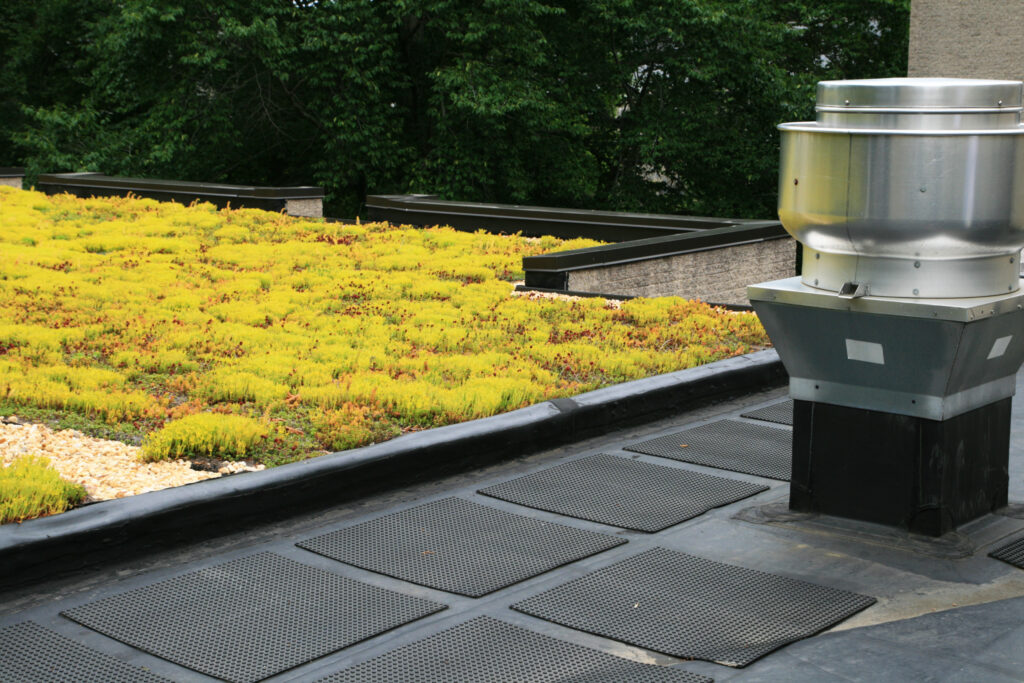
A green system, or a living roof, covers part or all of the roof with plants. Extensive green roofs require as little as three inches of soil and little maintenance. Intensive green roofs allow the variety of plants to expand, but they usually require more than eight inches of soil.
Advantages
- Reduces water runoff and improves water quality
- Reduces urban heat island effect
- Improves air quality because plants can capture airborne pollutants
- Provides natural insulation and can help lower energy costs
- Protects underlying roofing materials from UV rays and physical damage
- Reduces ambient noise
Disadvantages
- Can be more expensive than traditional roofing due to the need for additional layers like waterproof membranes, root repellent systems, drainage systems, and soil substrates
- Heavier than conventional roofs, so additional structural support might be necessary
- Requires more maintenance, including watering, weeding, and replacing dead plants
- Improper installation can lead to severe leaks
- Can attract pests
Solar
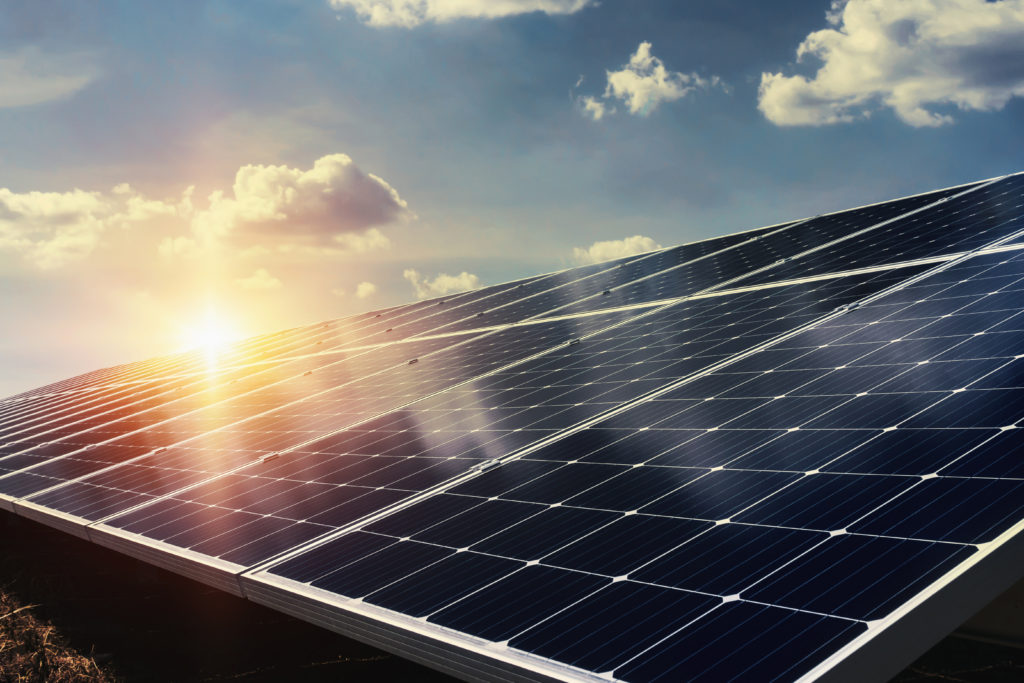
Solar roofing, usually shingles or panels, integrates solar power generation into a building’s existing roofing materials. The primary attraction of solar roofing is that it’s much more energy-efficient and can help property owners reduce their reliance on grid-supplied electricity.
Advantages
- Property owners could receive tax incentives depending on their state
- Reduces energy bills and overall carbon footprint
Disadvantages
- Can cost significantly higher than traditional roofing
- Contingent on sunlight, so the output is naturally lower during cloudy days or at night
- Technology upgrades might be needed in the future
- The additional weight of the solar panels or shingles can be a concern for some structures
- Local municipalities and even HOAs could have restrictions in place due to aesthetic concerns
Choosing the Right System
Roof Slope/Type
Do you currently have a flat roof or a low-slope roof design? The slope of your existing roof plays a significant role in choosing a material. The slope can range from nearly flat to moderately inclined, and it influences how well the roof sheds water and resists leaks.
If you’re unsure of your roof’s slope, look at the angle and drainage systems. Flat roofs appear nearly horizontal from the ground and typically have a very slight pitch (less than 2 degrees) to allow minimal water runoff, relying on drainage systems like internal drains or scuppers. Comparatively, low-slope roofs have a visible incline (2 to 10 degrees).
The chart below highlights which roofing systems are best for flat and/or low-slope designs.
Cost
The total cost of your roofing system includes the initial installation price, material costs, and long-term maintenance. EPDM and TPO generally are better for tighter budgets, while PVC, metal, green, and solar tend to cost more due to installation complexity.
Maintenance Requirements
Consider how much ongoing maintenance the roof will need over its lifespan and how much you are willing to spend on maintenance. Typically, EPDM, PVC, and metal have the lowest maintenance requirements.
Lifespan
The lifespan of your commercial roof will largely depend on the materials used, the quality of installation, and how well it is maintained. You can find more information about different roofing lifespans here, but here is a general overview:
- EPDM: 20 to 30 years
- TPO: 15 to 20 years
- PVC: 20 to 30 years
- Modified Bitumen: 20 to 30 years
- Built-Up Roofing: 20 to 30 years
- Metal Roofing: 40 to 60 years
- Green Roofs: 30 to 50 years
- Solar Roofs: 25 to 30 years
H3: Climate Considerations/Environment
What type of environment is your property in? Your climate will influence the performance of your roof. Each type of roofing system handles environmental conditions differently, so it’s important to choose materials and designs that can withstand your unique environmental challenges.
| Roofing Material | Roof Type | Initial Cost | Maintenance Needs | Lifespan | Environment |
| EPDM | Flat and low-slope roofs | $-$$ | Low | 20-30 years | Works well in a variety of climates—great for colder environments due to its flexibility and resistance to freezing temperatures |
| PVC | Flat and low-slope roofs | $$-$$$ | Low | 20-30 years | Good for areas with varying weather conditions and areas that may be subjected to chemical exposure |
| Modified Bitumen | Low-slope roofs | $$ | Medium | 20-30 years | Effective in both warm and cold climates, but is particularly good for roofs that may experience high traffic |
| TPO | Flat and low-slope roofs | $-$$ | Low to Medium | 15-20 years | Can be particularly good in hot climates, as long as the property is not in a location where the roof would be receiving a lot of direct sunlight every day |
| BUR | Flat roofs | $$ | Medium to High | 20-30 years | Works well in most climates, but best in temperature conditions due to its multiple layers/good insulation |
| Metal | Low-slope or steep roofs | $$-$$$ | Low | 40-60 years | Excellent for areas prone to extreme weather, like heavy snow or high winds, or in areas with high wildfire risks |
| Green | Flat roofs | $$$ | Medium to High | 30-50 years | Urban environments |
| Solar | All | $$$ | Low to Medium | 25-30 years | Most effective in sunny climates |
Schedule a Roof Assessment Today
Choosing a commercial roofing system is too important to leave to chance or guesswork. If you’re still not sure which roofing system is best for your property, contact Summit Commercial Roofing. Founded over 50 years ago, we’re a commercial-only roofing contractor serving businesses throughout Southeast Michigan. We can install, replace, and repair metal, PVC, and EPDM roofing systems.
Please fill out our online form today to get started with a roof assessment.

